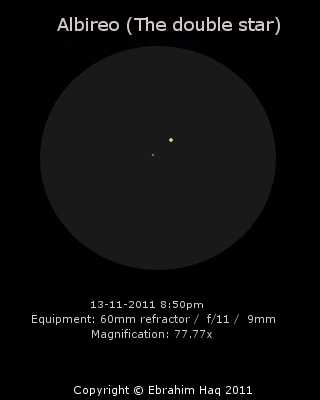
Object Name (Albireo A,Albireo B)
Object Type (Double Star)
Location (Karachi, Pakistan)
Date (13-11-2011)
Media (digital tools,Gimp 2)
Equipment: 60mm refractor
Focal length: f/11
Eyepiece: 9mm
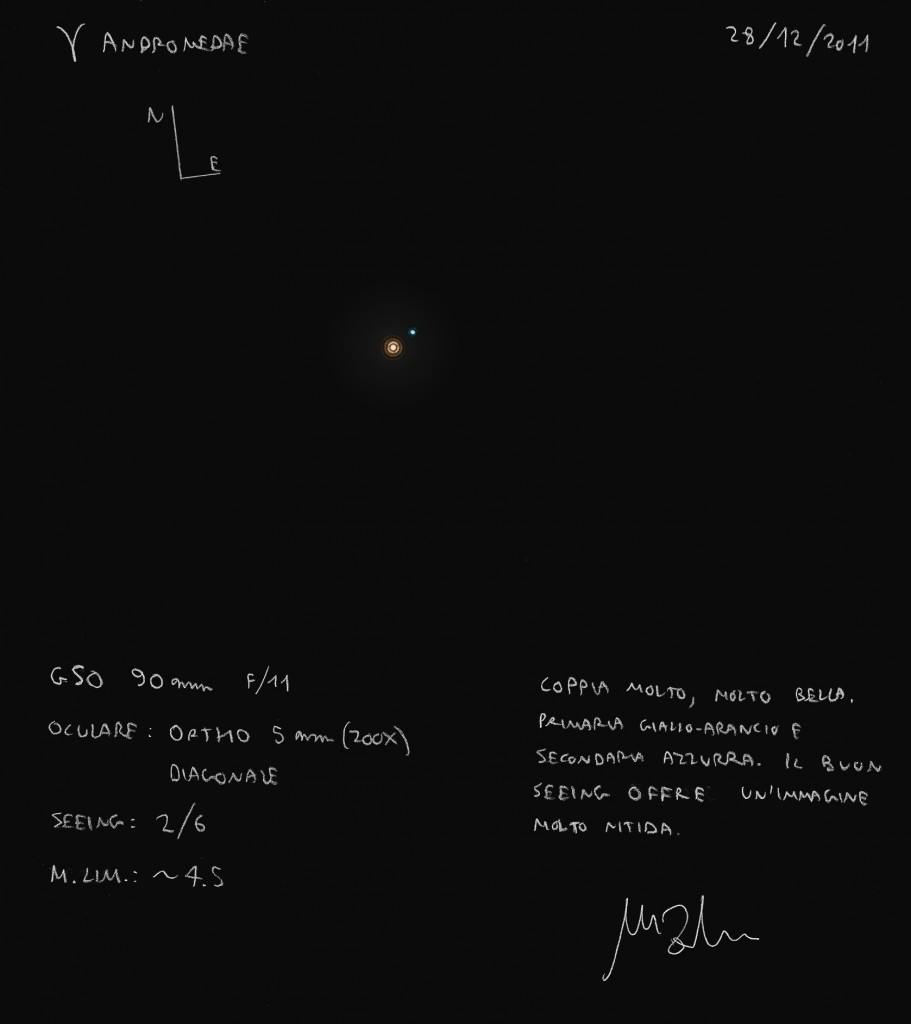
Object Name: Gamma Andromedae
Object Type: Double star
Location: Cittadella (Italy)
Date: December 28, 2011
Media: graphite pencil, white paper, inverted and colored in Gimp
Instrument: 90 mm achromatic refractor (f/11)
Eyepiece: Ortho 5 mm (200x) and diagonal
Conditions: Visual magnitude: 4.5 – Seeing: 2/6 (II Antoniadi)
One of the most beautiful double stars in the sky.
Clear skies,
Massimo
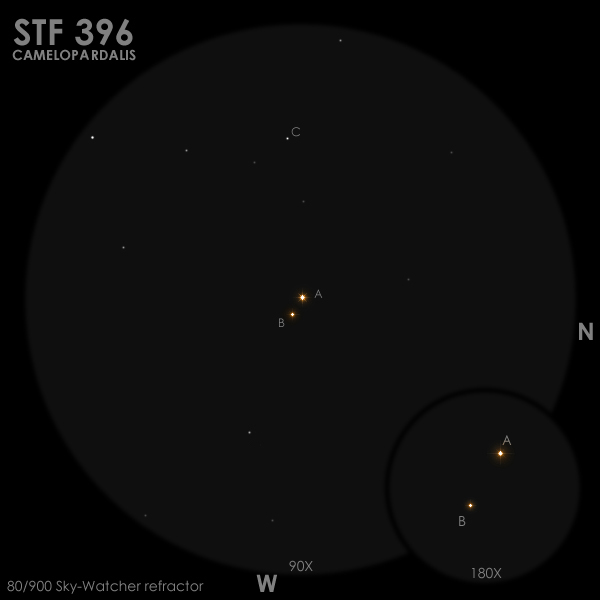
Hello! 🙂
Date: 2011-03-25 (evening)
Observer: Viktor Cseh
Object: Struve 396 multiple star (RA.: 03h 33m 32s, Dec.: +58°45’55”)
Components:
A – Magnitude: 6.3 Color: golden and yellow
B – Magnitude: 7.6 Color: golden and yellow Separation (from A): 21″ PA (from A): 244°
C – Magnitude: 10.8 Color: ————————– Separation (from A): 160″ PA (from A): 102°
Wonderful star pair in the Camelopardalis; bright and intensive colors. I recommend to everyone in the northern hemisphere!
My blog: viktorcsehdraws.blogspot.com
Clear skies! 🙂
Viktor
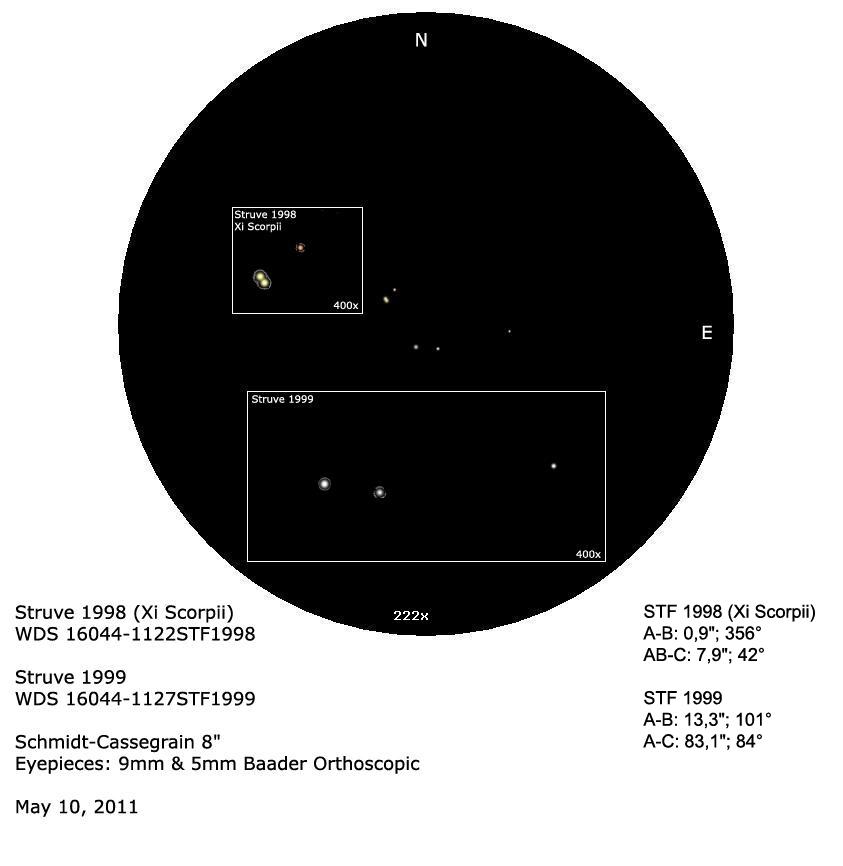
I send a drawing of two beautiful triple star: STF 1998 & 1999 in Scorpio.
Best Regards.
Giuseppe, Micello
————————————-
Struve 1998 (xi Scorpii) & Struve 1999.
Multiple stars.
Dozza (BO), Italy.
May 10, 2011.
Processing performed with Photoshop 6.0.
Telescope used: 8″ SCT.
Seeing: 8/10 Pickering scale.
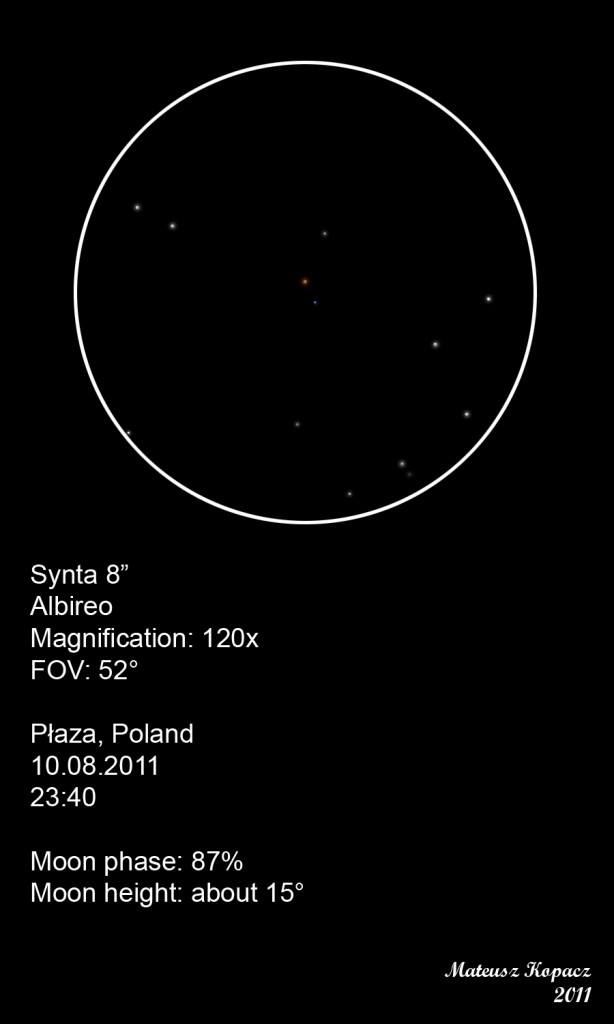
Object Type: Triple star system
Location: Płaza, Poland
Date: 10.08.2011
Media: graphite pencil, white paper, inverted, Photoshop CS2
Albireo is a beautiful, triple star system that consisting of Beta Cygni A – the orange, cool supergiant (in fact this is double star, but they’re too close to see it resolved. The second component is the Beta Cygni B – the Be star.
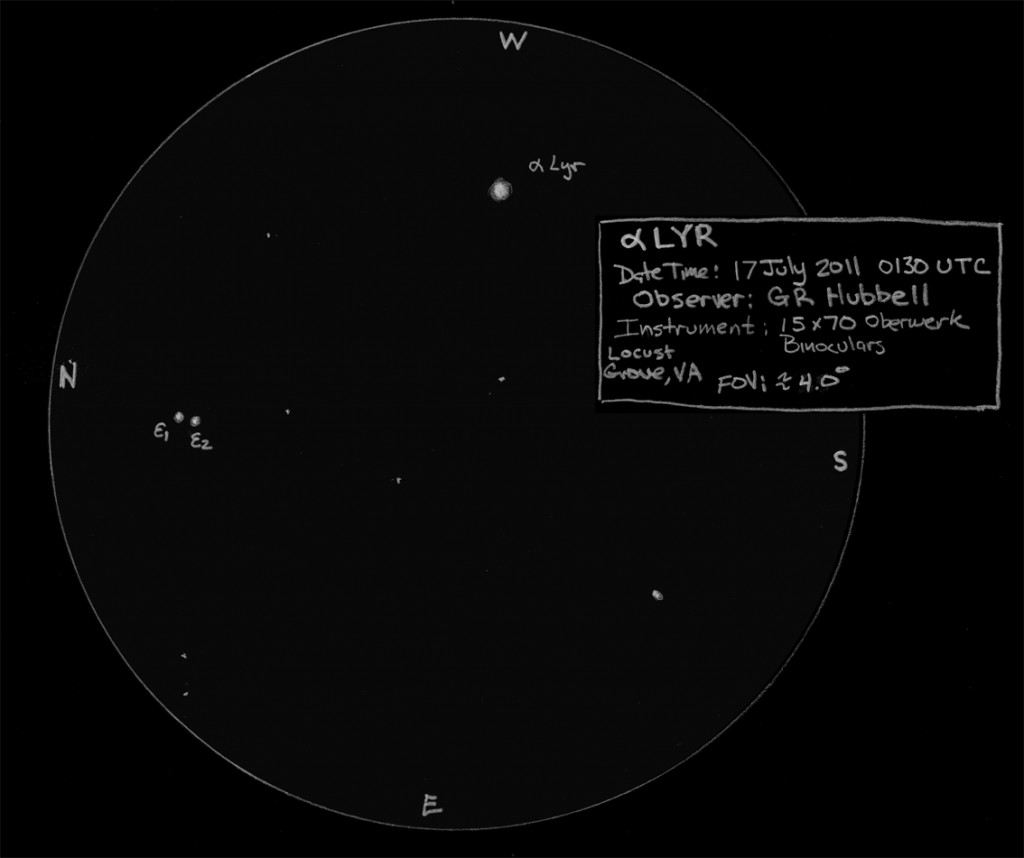
This is my first attempt at sketching a star field.
Object Name: Alpha Lyra – Epsilon 1 & 2 Lyra
Object Type: Double Star
Location: Locust Grove, VA
Date: 17 July 0130 UTC
Media: Graphite #2 Pencil on white paper. Photoshop inversion, enhancement.
Instrument: Oberwerk 15 x 70mm Binoculars
Weather: Clear/Partly Cloudy, 80 degF, Seeing 4/5, Transparency 4/5
Notes: Alpha Lyra drew my attention right at the end of twilight, and it was a beautiful sight with the Epsilon 1&2 double nearby. I could not quite discriminate (split) Zeta 1&2 to the lower right of Alpha, but I could tell it was elongated showing a hint that it was double.
Jerry Hubbell
Lake of the Woods Observatory (MPC I24)
Locust Grove, VA
Dear artists:
Hi;
Gamma Leonis (Algieba) and his companion.
Apparent Magnitude: +2.28
Companion Apparent Magnitude: +3.51
Distance from sun: 126 light years
Separation: 4”
Location: Iran/Tehran
25 March 2011. Time: 21.30 (local time)
Optic: Newt. 8”(Dabs.skywatcher)
Eyepiece: 10mm plossl
Moon: Waning Gibbous.
Seeing: 3
Pasha Majidi
Hi artists!
I send you a double “Albireo, the beautiful”.
This pair of stars, in the head of the Swan, I have observed many, many times with my telescope, but
every time I had been amazed of their very beautiful contrast in colours.
I have never seen them split with naked eyes, but with 10x 50 I have seen both.
I think Albireo is the finest double seen from Norway. More info on my sketch!
The observation was made outside Trondheim city, Norway.
Best regards, Per-Jonny Bremseth.
Webmaster’s note: Per-Jonny, I’m terribly sorry this beautiful sketch got overlooked in the cue. I’ll be looking for your other sketch that was overlooked as well. Your sketches are always very well done. For anyone who may have sent sketches that were never posted, just email Rich Handy at webmaster@asod.info and Jeremy Perez at
asod@perezmedia.net. Let us know your sketch was overlooked and indicate the subject and date emailed and I’ll do my best to retrieve it. Again my sincere apologies.
Rich Handy ASOD webmaster.
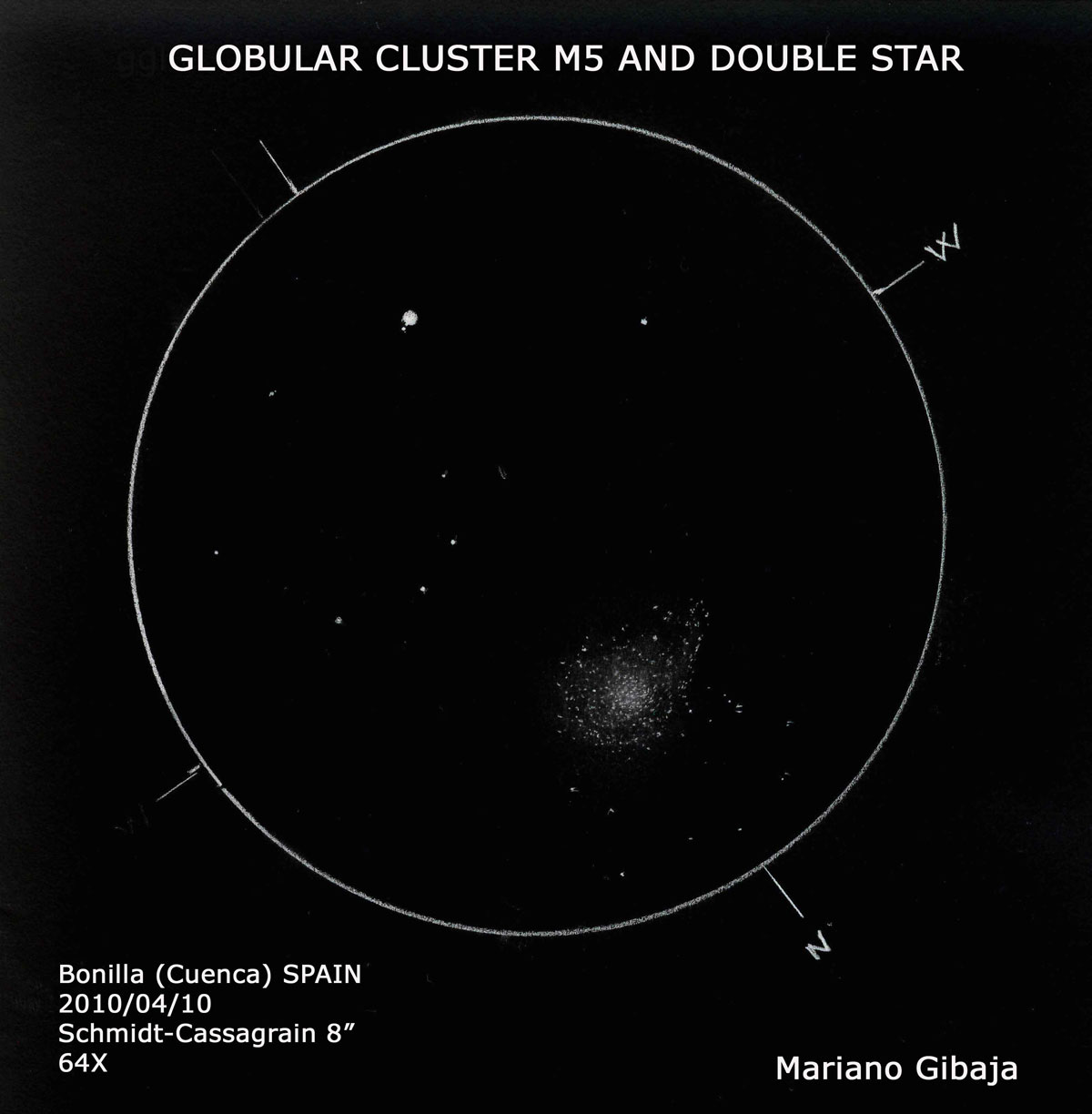
Messier 5 and STF 1930
Sketch and Details by Mariano Gibaja
Object Name: M 5 (NGC5904) and STF 1930 in Serpens constellation.
Object Type: (Globular Cluster/Double Star)
Location: Bonilla (Cuenca) SPAIN
Date: 2010-April-10; UT: 23;30
Medium used: Graphite pencil one white paper. Photoshop:inverted
Equipment used: SCT 8″ (64X)
The observation of this globular cluster is very rewarding. It finds itself
in Serpens’ constellation, approximately 25.000 light years away. M5 and M13
are the two most brilliant globular cluster in the northern hemisphere. It
has a very thick core and it can be observed how ramifications of starts
have their origin in it, the famous ‘spider legs’ that give to the cluster
its elliptical shape. The image of this beautiful cluster is completed with
the star 5 SER, with a magnitude of 5. But actually, if we observe closely
we can see that it is a double star. In this case it is the STF 1930, make
up of the star of magnitude 5 and its partner of magnitude 10, with a
separation of 11,4”.
I have done this draft in the observation area of the Astronomical
Association of Madrid (Agrupación Astronómica de Madrid) in Bonilla, Cuenca.
The weather was good and the temperature was around 3º C.
Do not miss the spectacle that this globular is offering and that will be
with us during the warm summer nights.